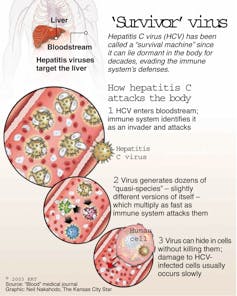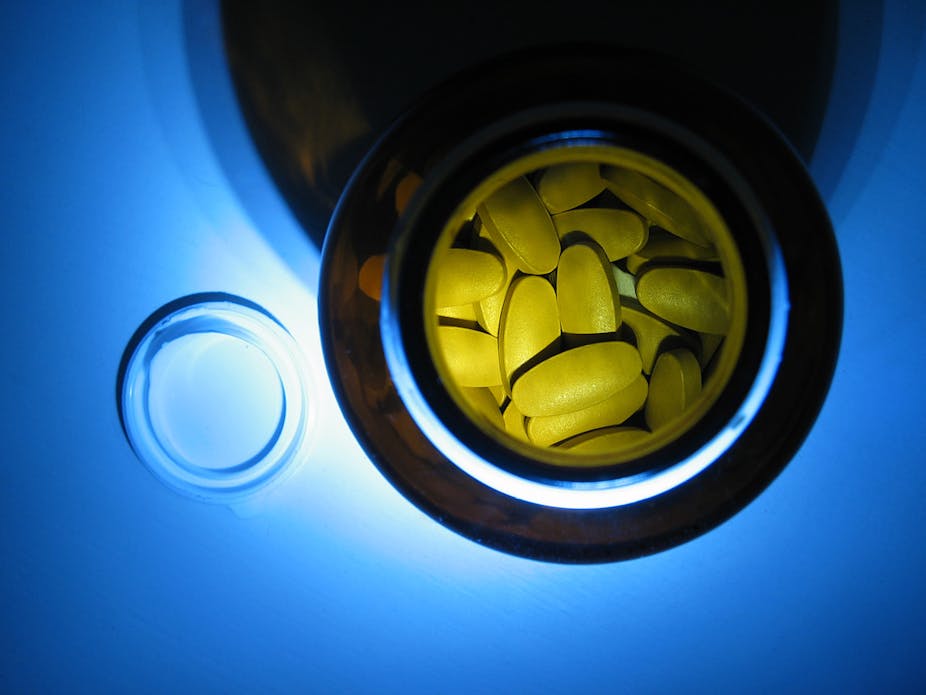It’s twice as common as type 1 diabetes. It kills more Australians than HIV. One in every 100 of us lives with hepatitis C, but the disease receives little attention. Worldwide, around 150 million people are chronically infected and more than 350,000 lives are lost each year.
Nonetheless, earlier this year, Australia’s Pharmaceutical Benefits Advisory Committee (PBAC) declined to subsidise a new curative drug for hepatitis C called sofosbuvir (Sovaldi). The PBAC’s reason for its refusal was the drug’s potential impact on the health budget.
The proposed Australian price for Sovaldi has not been disclosed, but in the United States a three-month course of treatment costs US$84,000. The PBAC’s decision reflects a concern felt around the world: how can we treat so many people at such a high price?
A steep price
The current situation with hepatitis C recalls the fight over a decade ago for HIV drugs to be made affordable. The first drugs for HIV were approved in the United States in the late 1980s, and combination highly active anti-retroviral therapy (HAART) first became available in 1996.
The price of these patented medications prevented most people in heavily affected African countries from getting treatment until after 2001, when an Indian manufacturer made generic versions available. This brought the price down from over US$10,000 per patient per year to just a few hundred dollars.
Almost six million people died of HIV in sub-Saharan Africa in the intervening years; a great many of these deaths would have been prevented with affordable drugs.
Now the first chapter of that story seems to be repeating itself. Several life-saving medicines for hepatitis C have been developed, but they are priced out of reach. International trade agreements, as they stand, will prevent universal access to affordable generic versions of the drugs.
Many people with hepatitis C live in middle-income countries, such as Russia and China. While they are wealthier than the countries devastated by HIV, these nations still cannot afford the new cures at current prices.
Patients must take at least two drugs in combination. A single three-month course of sofosbuvir with its partner drug ledipasvir is currently priced at US$94,000. This is over 15 times the average annual income in China.
The traditional treatment for hepatitis C takes at least six months, can cause severe side effects and is not always effective.
Treatment uptake in Australia has always been low. Out of the almost quarter of a million Australians living with the virus, over 30% are believed to have already developed moderate or severe liver damage, but fewer than 2% are treated each year.
This is one of the reasons liver cancer is the fastest-increasing cause of cancer-related death among Australians.

Australia has recently approved three “first-generation” new drugs. Each of these can be added to traditional treatment to improve its efficacy and reduce the time required. But, right now, these drugs are available only to people with the hardest-to-treat form of the virus. Side effects remain a significant concern.
Leaving people behind
With shorter treatment duration, fewer side effects and higher efficacy, combination treatments with “second generation” drugs such as sofosbuvir should make treatment possible for much larger numbers of people.
But if the drug had been approved in Australia at the proposed price, the government would likely have considered it necessary to restrict access. If even 5% of the 230,000 Australians living with hepatitis C were to receive combined treatment with sofosbuvir and ledipasvir at US$94,000 per course, the drug cost alone would exceed US$1.1 billion.
The outlook for heavily affected middle-income countries is even more sobering. With larger populations, higher prevalence and fewer resources than Australia, neither their governments nor their citizens can pay current prices.
Sofosbuvir’s manufacturer, Gilead Sciences, has signed a deal with India to allow limited manufacturing of generic versions of the drugs for many low-income countries. This includes some heavily affected countries such as Egypt.
While this is very welcome, as Médecins Sans Frontières (Doctors Without Borders) has pointed out, a huge number of people with hepatitis C live in countries that have been left out, meaning they have little hope of accessing the drugs.
Researchers at the University of Liverpool have estimated that an entire three-month course of sofosbuvir can be produced for under US$140.
Perils of patent protection
The argument for patent protection for high drug prices is usually that companies need to recoup research costs, which may sound reasonable. But sofobuvir’s manufacturers did not develop this blockbuster drug themselves.
Gilead purchased the drug’s original developer for US$11.2 billion in 2011. In just the first nine months of this year, the drug’s sales totalled US$8.6 billion. This suggests the company is likely to recoup the cost of the acquisition by Christmas 2014.
The first patents for sofosbuvir are not due to expire for at least 15 years. Long after they have covered the cost of the drug’s development and that of Gilead’s speculative purchase of the right to produce it, it appears patients and taxpayers will be expected to continue paying a huge price for this life-saving medicine.
More than a decade after the first victories in the battle for affordable HIV drugs, the gulf between the priorities of large pharmaceutical companies and those of governments, affected communities and the general public is again highlighted.
The new treatments for hepatitis C should herald a revolution; a deadly disease can now be cured quickly and painlessly for a few hundred dollars. But unless affordable treatments are made universally available, millions of people in urgent need will be left behind.
Nobody who recognises the human cost of hepatitis C could question the value of these new drugs. But even in wealthy countries such as Australia, we are being forced to question their price tags.

